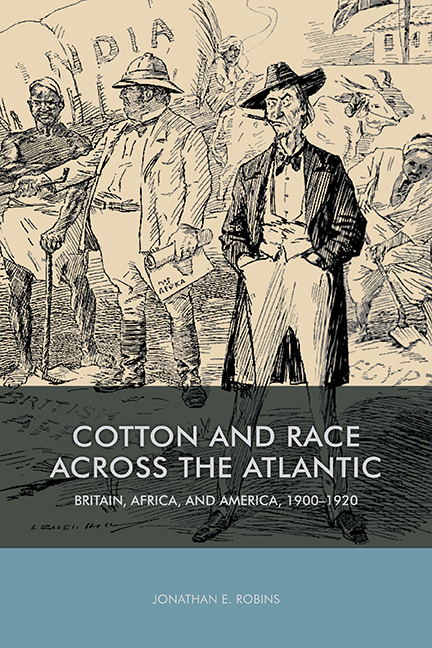Book contents
- Frontmatter
- Contents
- List of Illustrations
- Preface
- Abbreviations
- Introduction
- 1 The Cotton Crisis: Lancashire, the American South, and the Turn to “Empire Cotton”
- 2 “The Black Man's Crop”: The British Cotton Growing Association and Africa
- 3 “The Scientific Redemption of Africa”: Coercion and Regulation in Colonial Agriculture
- 4 “King Cotton's Impoverished Retinue”: Making Cotton a “White Man's Crop” in the American South
- 5 Cotton, Development, and the “Imperial Burden”
- Notes
- Bibliography
- Index
5 - Cotton, Development, and the “Imperial Burden”
Published online by Cambridge University Press: 13 July 2019
- Frontmatter
- Contents
- List of Illustrations
- Preface
- Abbreviations
- Introduction
- 1 The Cotton Crisis: Lancashire, the American South, and the Turn to “Empire Cotton”
- 2 “The Black Man's Crop”: The British Cotton Growing Association and Africa
- 3 “The Scientific Redemption of Africa”: Coercion and Regulation in Colonial Agriculture
- 4 “King Cotton's Impoverished Retinue”: Making Cotton a “White Man's Crop” in the American South
- 5 Cotton, Development, and the “Imperial Burden”
- Notes
- Bibliography
- Index
Summary
“The commercial interdependence of nations was illustrated in a manner never to be forgot when the Great War of 1914 broke out,” American historian James Scherer observed in 1916. Scherer had been working on the first comprehensive history of cotton from antiquity to the present when the war began, and the confl ict provided a dramatic conclusion for his story. Cotton had been the emblematic industry of what many scholars regard as the first era of “globalization,” and the war shattered the international division of labor and free trading conditions that had made global economic integration possible. As Europe mobilized for war, the machinery of international trade ground to a halt. Stock exchanges and commodity markets around the world closed their doors. In Africa, expatriate employees of the BCGA and the Colonial Office, as well as many local farmers, abandoned cotton and joined the war effort. Africans waited apprehensively to see whether the war would ruin their trade, or perhaps even topple their colonial rulers. In Lancashire, merchants stopped buying textiles and mills stopped making them. Mill operatives and their employers enlisted and prepared to join the fight in France. Meanwhile, across the Atlantic, American farmers were preparing to harvest the biggest cotton crop in history, over sixteen million bales.
The war produced calamitous changes in the cotton industry, and marked the end of the Atlantic-centered world of cotton. The nineteenth century began with the emergence of a bipolar system, concentrating textile manufacturing in Britain and cotton agriculture in the United States. Africa, the vital source of labor for this system, was marginalized. The colonial cotton projects of the early twentieth century marked another transition, this time toward a multipolar system in which cotton agriculture and cotton manufacturing diffused across the globe. After the First World War, the world of cotton fractured into several competing systems, representing the efforts of imperial powers to achieve self-sufficiency and shut out competitors. Lancashire and the American South remained important centers in this environment, but their infl uence waned. Instead of replacing the American South, Britain's African colonies joined a growing cast of peripheral commodity producers scattered across Africa, Asia, and Latin America.
- Type
- Chapter
- Information
- Cotton and Race across the AtlanticBritain, Africa, and America, 1900–1920, pp. 200 - 230Publisher: Boydell & BrewerPrint publication year: 2016



